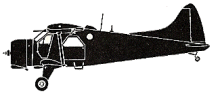
ASN Wikibase Occurrence # 290450
This information is added by users of ASN. Neither ASN nor the Flight Safety Foundation are responsible for the completeness or correctness of this information.
If you feel this information is incomplete or incorrect, you can submit corrected information.
| Date: | Wednesday 30 July 2014 |
| Time: | 22:30 LT |
| Type: |  de Havilland Canada DHC-2 Beaver |
| Owner/operator: | Glenn Air Inc. |
| Registration: | N62197 |
| MSN: | 1177 |
| Year of manufacture: | 1957 |
| Total airframe hrs: | 12466 hours |
| Engine model: | P & W R-985-AN-14B |
| Fatalities: | Fatalities: 0 / Occupants: 2 |
| Aircraft damage: | Substantial |
| Category: | Accident |
| Location: | Talkeetna, Alaska -
 United States of America United States of America
|
| Phase: | Standing |
| Nature: | Executive |
| Departure airport: | Talkeetna, AK |
| Wasilla, AK (IYS) | |
| Investigating agency: | NTSB |
| Confidence Rating: |
The airplane had been outfitted with a large, bulk fuel tank to transport fuel to remote sites. After a fuel delivery, the airplane departed from a soft, wet, and muddy sod-covered airstrip that was 1,400 ft long and 50 ft wide with a slight downhill grade. The pilot reported that, during the takeoff run, the airplane failed to become airborne before reaching the end of the airstrip, so he aborted the takeoff. The airplane overran the airstrip and sustained substantial damage to the wings and fuselage.
The operator stated that, before the fuel delivery, the airplane was loaded with about 180 gallons of aviation fuel and that, after arriving at the airstrip, the pilot got out of the airplane, connected a hose and transfer pump system to the bulk fuel tank, and operated the transfer pump for about 5 minutes. Postaccident examination of the wreckage revealed that all 180 gallons of fuel were still in the bulk fuel tank. According to the operator, the pilot did not open the drain valve to allow the tank to drain nor did he verify that the tank was empty before departing. Further, the operator stated that the pilot departed about midfield using only the last 750 ft of airstrip that remained; the estimated takeoff distance for the flight was between 800 and 900 ft.
Probable Cause: The pilot's inadequate preflight inspection that did not detect that the bulk fuel tank was full and led to an unanticipated heavy airplane weight and his failure to use the entire soft, wet, and muddy airstrip length for takeoff, which resulted in a takeoff overrun.
Accident investigation:
 |
|
Sources:
NTSB ANC14LA058
Location
Revision history:
| Date/time | Contributor | Updates |
|---|---|---|
| 06-Oct-2022 15:17 | ASN Update Bot | Added |
Corrections or additions? ... Edit this accident description
The Aviation Safety Network is an exclusive service provided by:


 ©2024 Flight Safety Foundation
©2024 Flight Safety Foundation